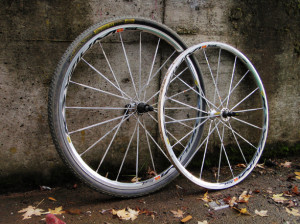Pneumatic tires were invented in 1888 by John Dunlop, and were an immediate success because they were a more effective and lighter alternative to solid rubber tires. Because Dunlop’s tires were hard to repair, Edouard Michelin invented detachable tires that could be detached from the rim. Michelin’s invention was the predecessor to the modern clincher tire. Tubular tires were later created by racers who were looking to put more pressure into their tires. These tires increased speed and handling abilities.
The type of bicycle tire you choose makes a significant difference in your riding performance. Tires affect your speed, balance, and turning. When not properly inflated or maintained, tires can ruin your ride altogether. With so many tire options available on the market, it is worth taking the time to ask the right questions to determine which tires best fit your bike and riding purposes. When you are properly informed, you can choose tires that will help make your ride much easier.
Three Types of Tires
While there are really only two main types of bicycle tires (Tubular and Clincher), a third type, Open Tubular, has recently emerged as a hybrid between the existing two. These “types” refer to how the bicycle tire attaches to the rim. Below we list some of the pros and cons of choosing each tire.
Clincher
Clincher tires are the most common tire-types on road bicycles. They have a woven cloth casing. A long wire runs along both sides of the tire, fitting under the edge of the rim and holding the tire in place when the tube is inflated. These tires are the most common because they are the easiest to access and to repair when you experience a flat tire.
Pros
- These tires are cheap and durable
- These are the most common tire-type, so they are easily replaced and are carried at any bike store
- Clincher tires usually last longer than tubular tires
- A generally thicker tread is present in clincher tires
Cons
- The nicest clinchers are not as nice as the nicest tubulars
- If you are racing, these tires may slow you down
Tubular
Less common tubular, or “sew-up,” tires consist of a Seamless Latex Inner Tube that is stitched to a sewn cloth, which is glued to the rim. There are two kinds of tubulars: handmade and vulcanized. Handmade tubulars have a higher thread count and are generally made better (and are therefore more expensive) than vulcanized tubulars. These are preferred by professionals because the flexible tubulars provide faster racing.
Pros
- Handmade tubulars are very strong, flexible, and durable
- Tubular tires provide smooth, good-quality riding
- Tubular tires are built with decreased rolling resistance, creating faster tires
- High-thread count in handmade tubulars is effective at preventing flats and any additional road damage
Cons
- Cheap tubulars are hard to repair in the case of a flat because the casing must be un-stitched to access the tube
- Unstitching and resewing the casing around the tube causes fast wear-and-tear
- Because tubulars are held to the rim with glue, they can be ripped when trying to change the tube or fix a patch
- Long descents are a problem with tubulars, especially for bigger riders
- Heat build-up in the rim with long, heavy braking can melt the glue, causing the tire to shift
- The worthwhile tubulars are more expensive than clinchers
Open Tubular
These attach to the rim like a clincher but are made using a process similar to the tubular tires. This makes it easier to both change the tube or fix a flat, yet benefit from the strength of the high-thread-count casing prevalent in tubulars.
Source: BikeRaceInfo
Photo courtesy of: Gabriel Amadeus

